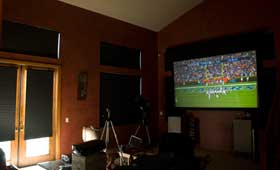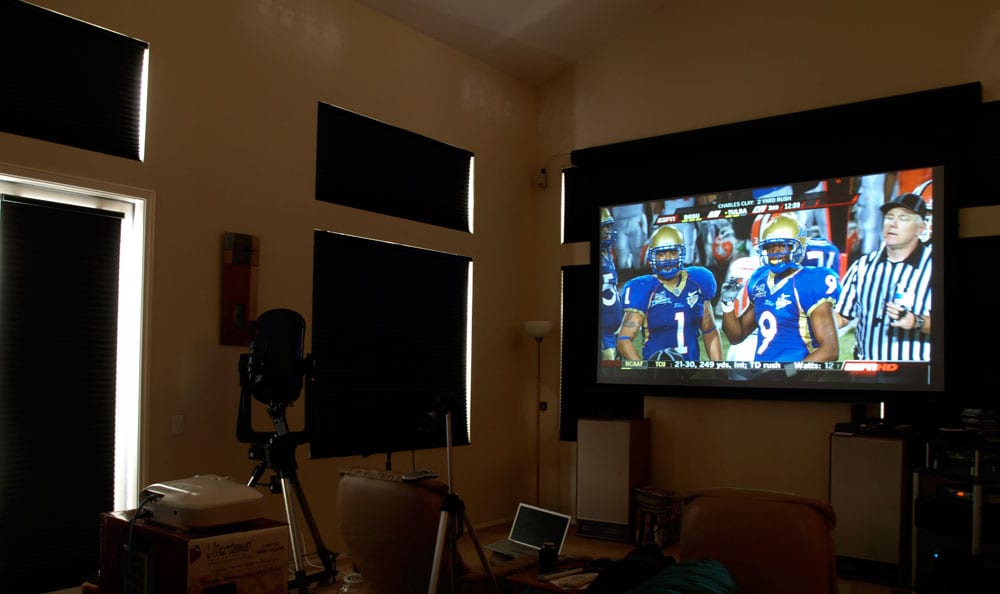W1070 Projector Screen Recommendations
This BenQ W1070 qualifies as a light canon. (That translates to "really bright".) Even for 3D viewing, a really high gain screen shouldn't be needed This simplifies and lets you pick the screen that best suits the room you are in, the varying levels of ambient light you might deal with, and also how big a screen you choose.
The BenQ W1070 does great filling my 124" Studiotek 130 screen (1.3 gain, 2.35:1). And that's in Smart-Eco! When it comes to ambient light, obviously it's best when it comes from the sides, so that you can choose a screen that will minimize that ambient light.
If your room has ambient light but not from the sides, rather straight back, those HC gray's aren't going to help that much, so you might be better off with a nice "plus gain" screen - say 1.3 to 1.6, to brighten the image. That won't help though if your ambient light is back where the projector is. Some HC gray screens are better at rejecting light coming from above, than others.
Whatever your room for the BenQ W1070, I offer some advice, if you have the option to try to improve the room.
Should you be able to pull it off, darken your walls and ceiling, and if possible, also the floor of your room, to dramatically improve your experience. Keep in mind with a bright projector like this BenQ, however, you can cut through quite a bit of ambient light when you want to watch sports, regardless of walls... 2000 lumens can go a long way. If your room is mostly off white, even just darkening it a shade or two will make a difference.
Even our testing room with about half of its wall surfaces set to off-white, the projector easily handles my 110" screen (2.35) when filling the full width with a widescreen movie in 3D.
If you have some of your ambient light coming from the sides, I'd definitely suggest a high contrast gray. If you are going to be a long term home theater type person, you might splurge for your first screen. Expensive screens like the Stewart Firehawk and Screen Innovations Black Diamonds can work real magic in a family room type world.
Much of the content below is reproduced in a number of reviews. It is designed to give you some idea of how a room behaves differently after the wall and ceiling brightness is reduced. Also how much brightness it takes to get a good image on a bright screen:
First Image below taken using 128" screen, an old (2007) Sony VW60. A projector that we measured at a max of under 700 lumens. This room at that time, was "watch football during the day, everything else, at night only." (My other theater room in that house was far darker.)
The second image - same setup, the old Epson 1080UB - several generation forerunner to the Epson 5020UB, and twice as bright as the Sony. The 1080UB at its brightest was very bright for its day (2008).
Ed. Note: W1070 calibrated is still a few hundred lumens brighter than that old Epson as photographed.
That's pretty impressive, is it not? With the Medium rust walls, a bit darker ceiling (everyone still thought it was white - as it was the lightest surface in the room), the shades opened a bit, yet thanks to the darker surfaces, the image is far better looking than the first image above.
I loved having that Stewart Firehawk G3 (in the images above) in my last home for handling a light surfaced room. As I said, it was 128" diagonal in a room with a cathedral celing. When I started out there, all the walls were off white, as was ceiling, and carpet was gold. Lots of windows, which I covered with pleated shades - but with no channels. The Firehawk allowed me to have a good picture even with a moderate amount of light (when the room is "you can read a newspaper easily" bright)
That HC gray screen rejects most of the side lighting. This allowed me to even have my slide window shades open a few inches on sunny days, and still have a large, great football image. If your ambient is coming from straight back near the projector, like rear windows, the HC gray won't help you.
Ultimately, an HC gray is going to be the best choice for most folks with lighter rooms, and especially if the lights are on the sides. Consider the especially the Firehawk G3, and the various Screen Innovations Black Diamond screens (different gains, etc.) which are especially good, but also relatively pricey. More affordable: Elite's HC Gray, Da-lite's HC-Da-Mat, possibly Stewart's new Cima series I haven't worked with any of them yet.. Typically we're talking screens with gains of 0.8 to 1.1 gain. Trading a bit of brightness for some ambient light rejection is a plus. (Note HC screens are a touch darker in the corners/sides.)
Don't get me wrong, you can go with a standard white surface, but in a light surfaced room, you'll also appreciate the gray surface's ability to lower the overall black levels, in addition to helping "reject" much of the ambient light that isn't coming from where the projector is (straight back).
One alternative to the HC gray, might be a "high power" screen, one with lots of gain - such as 2.0 or higher. Like the HC gray screen there are tradeoffs. I find the roll off from the very high gain screens to be much worse than the less than perfect edge to edge brightness of an HC gray screen. I avoid hi-power screens, but I know some very serious projector owners who swear by them, for the right situation
OK, what about 3D? In a room like my old one above, the HC gray type screens although a little less bright, are still your ticket if you have side ambient light to deal with. Otherwise, go with the higher gain whites.
Bottom line: The projector has the brightness. Now find the right surface screen to deal with the room. All that brightness gives you a good deal of leeway, and it means you can tackle a room a bit worse, lighting wise, than the competition is able to handle.



